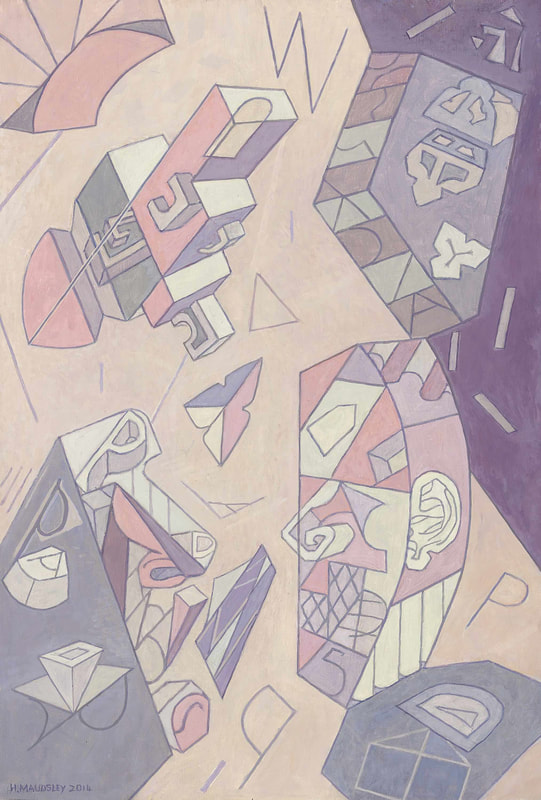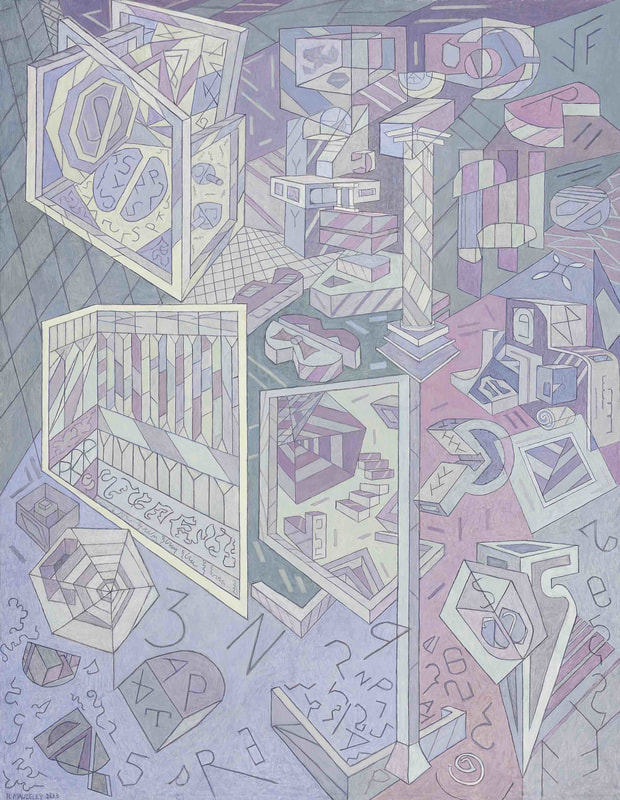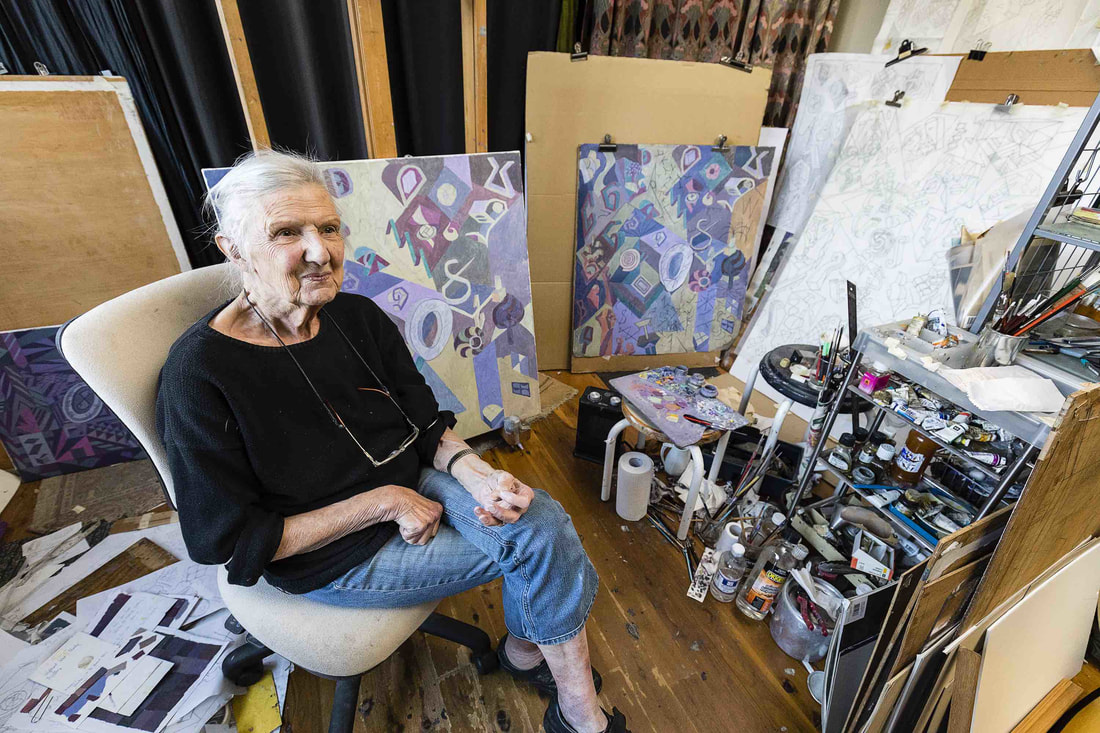Helen Maudsley: In praise of slow art  Helen Maudsley The Rose Petal Scrolls, become the Scrolls of our Ancient Past; of the Law; of Wigs, still worn. The Hands of Now, of Doing. The Pear that is Flesh and Heart. The Conflict with Arrogance. Also, the Flicker of Life, and the Question Mark., 2014 oil on canvas 74.5 x 80.5cm Collection of the artist, Melbourne. Courtesy of Niagara Galleries, Melbourne. © Helen Maudsley So much of what we experience in our daily lives is measured in nanoseconds and perceived in soundbites so that Andy Warhol’s promise of 15 minutes of fame increasingly appears as a utopian dream. Who nowadays has 15 minutes to spare? – and anyhow Warhol probably never said it. Viewers at art galleries, exhibitions and museums, on average, spend less than 30 seconds looking at an artwork, most of that time spent reading the caption, establishing the viewing distance or posing for a selfie. Although six million people a year may come to see the Mona Lisa in Paris, according to the Louvre, they spend about 15 seconds with it. Of course, some people spend much longer looking at art and even manage do it without a phone or camera in hand. In the last few decades there has been a growing realisation that the world is out of joint, perhaps more so than ever before, and we simply have to slow down to comprehend things more fully, to more completely enjoy and digest our food, culture and even procreation. So we have the slow food movement, slow travel, slow sex and slow art. Museums around the world celebrate slow art day, where the invitation is to slow down and partake more fully of the art experience. Contrary to a popular argument that slow art almost entirely depends on the viewer’s perception, I feel that some artworks do not warrant more than a single glance and are designed for instant gratification and the immediate ‘wow’ factor, while others are not intelligible without prolonged viewing and contemplation. Leaving aside installations, videos and controlled environments, for example The Aboriginal Memorial, Bill Viola, James Turrell and Richard Serra, where the medium makes a physical demand on the viewer to physically slow down to see the work, there are art objects that demand that you enter the work and engage with it, to see it. A Byzantine icon, a painting by Vermeer, Velázquez or Rembrandt are examples of traditional slow art that engage the spirit and the intellect. It is possible to walk past them casting only a cursory glance, but that is like saying that you know Bach’s The Well-Tempered Clavier because you have seen the record cover or heard the ringtone. A commercial jingle or commercial advertising design that passes as painting in some galleries may have an ephemeral popularity and can be fully comprehended within a matter of seconds as there is nothing beneath the surface, but slow art engages the spirit and the intellect and that requires time. Helen Maudsley is a great master of slow art and is the subject of a major exhibition at the National Gallery of Victoria. Since I first encountered her work, about forty years ago, I was struck by its complexity, its quiet, reserved beauty and the intellectual engagement. It is unlike anybody else’s work – intricate and elaborate, lucid and cerebral – but at the same time aesthetically pleasing with its cool palette and pastel tones. The paintings do not leap off the walls crying for attention, but once you pause for a moment, look and enter the work, you are drawn into a visual and intellectual labyrinth of endless complexity. The exhibition at the National Gallery consists of thirty works, predominantly oil paintings, but also a few pen and ink drawings, and is selected from the artist’s work from the past five years. Titles in her art are of critical importance, but they act as poetic evocations, rather than pointing us to objects to be located within a painting. One of the titles from the present exhibition reads, Our Civilised Minds, Our Feral Mindlessness, Our Inherited Language; our Re-configuration. The Hyena Laugh (2013), while another 4 Roses in a Vase. 4 Heads and One Face. 4 People and the Golden Pillar (2014). Other titles are more socially engaged and include, You’ve Got what I want, and I’m going to Get it (2015) and I. Me. You. ‘I don’t see You. You don’t see Me. You see Me as you want me to be. I see You as I want You to Be. Each one’s Separation and Difference’ (2017). Maudsley is not a difficult artist to appreciate, but there is a certain threshold to overcome before you can enter her intriguing and perplexing world. It is one that operates on a visual, rather than a literary level, where the individual ideographs assert their own lyrical magic and weave their philosophy of being and nothingness, of knowing and not knowing. This is a profound exhibition by a mature artist who over decades has devised a unique pictorial language of power, beauty and a haunting lyrical intensity. Helen Maudsley, Our knowing and not knowing is on at the National Gallery of Victoria – Australia, Federation Square, Melbourne, 17 November 2017 – 12 March 2018
4 Comments
19/11/2017 06:32:20
Thank you sasha for an introduction to such beautiful work. Im a lover of art that has a thought process involved in the viewing process.
Reply
19/11/2017 09:24:11
I was at Helen's floortalk yesterday and it didn't fail to please. I consider her to be one of our truly gifted artists; articulate, thoughtful, visually imaginative and an intellect. I enjoyed your review enormously Sasha thank you.
Reply
22/11/2017 19:15:48
Sounds good Sasha, We look forward to seeing the exhibition. M & L
Reply
Your comment will be posted after it is approved.
Leave a Reply. |
GRISHIN'S ART BLOG
Sasha Grishin AM, FAHA is the author of more than 25 books on art, including Australian Art: A History, and has served as the art critic for The Canberra Times for forty years. He is an Emeritus Professor at the Australian National University, Canberra; Guest Curator at the National Gallery of Victoria, Melbourne; and Honorary Principal Fellow, Faculty of Arts, at the University of Melbourne. Archives
June 2024
Categories
Keep up-to-date with Sasha Grishin's blog with the RSS feed.
RSS offers ease of access and ensures your privacy, as you do not need to subscribe with an email address. Click here to download a free feed reader |







 RSS Feed
RSS Feed